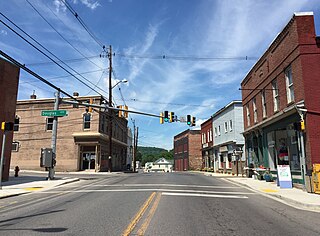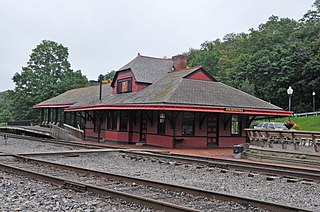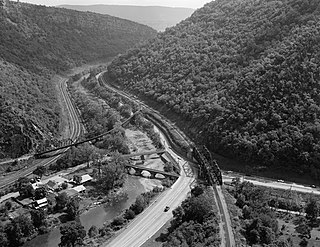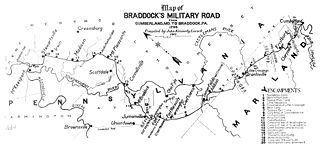Related Research Articles

Barton is a town in Allegany County, Maryland, United States, located along the Georges Creek Valley. It is part of the Cumberland, MD-WV Metropolitan Statistical Area. The population was 457 at the 2010 census.

Lonaconing is a town in Allegany County, Maryland, United States, located along the Georges Creek Valley. It is part of the Cumberland, MD-WV Metropolitan Statistical Area. The population was 1,214 at the 2010 census.

Georges Creek Valley is located in Allegany County, Maryland along the Georges Creek. The valley is rich in wide veins of coal, known historically as "The Big Vein." Coal was once extracted by deep mines but is only mined today through surface mining. The Georges Creek Valley was once a major center for the US coal industry.
Maryland Route 36 is a 29.43-mile (47.36 km) state highway located in Allegany County, Maryland, United States. MD 36's southern terminus is at the West Virginia Route 46 (WV 46) bridge in Westernport and its northern terminus at U.S. Route 40 Alternate near Cumberland. Between Westernport and Frostburg, it is known as Georges Creek Road, and from Frostburg to Cumberland it is known as Mount Savage Road. Like the majority of Maryland state highways, MD 36 is maintained by the Maryland State Highway Administration (MDSHA).

The Lehigh Crane Iron Company was a major ironmaking firm in the Lehigh Valley from its founding in 1839 until its sale in 1899. It was founded under the patronage of Josiah White and Erskine Hazard, and financed by their Lehigh Coal & Navigation Company, which hoped to promote the then-novel technique of smelting iron ore with anthracite coal. This was an important cost and energy savings technique, since either an expensive charcoaling nor coke producing process and transport costs was totally eliminated so produced a great acceleration in the underpinnings of the American industrial revolution.

The Cumberland and Pennsylvania Railroad (C&P) was an American railroad which operated in Western Maryland. Primarily a coal hauler, it was owned by the Consolidation Coal Company, and was purchased by the Western Maryland Railway (WM) in 1944.

The Maryland Mining Company is a historic coal mining, iron producer and railroad company that operated in Allegany County, Maryland.

The Eckhart Branch Railroad is a railroad that operated in the Cumberland, Maryland area in the 19th century.
The Georges Creek Railroad was a railroad operated by the Georges Creek Coal and Iron Company in Western Maryland. The railroad operated from 1853 to 1863, when it was acquired by the Cumberland and Pennsylvania Railroad (C&P).

Cumberland, Maryland is named after the son of King George II, Prince William, the Duke of Cumberland. It is built on the site of the old Fort Cumberland, a launch pad for British General Edward Braddock's ill-fated attack on the stronghold of Fort Duquesne during the French and Indian War.
The Potomac Wharf Branch was a historic railroad located in Maryland. It was built by the Maryland Mining Company between 1846 and 1850, as an extension to the Eckhart Branch Railroad. The Potomac Wharf Branch crossed Wills Creek on a bridge just east of the present Route 40 road bridge near Cumberland. Rail tracks from this line may still be seen near some billboards, and a gas station in that area.
The Ghost Town Trail is a rail trail in Western Pennsylvania that stretches 36 miles (58 km) from Black Lick, Indiana County, to Ebensburg, Cambria County. Established in 1991 on the right-of-way of the former Ebensburg and Black Lick Railroad, the trail follows the Blacklick Creek and passes through many ghost towns that were abandoned in the early 1900s with the decline of the local coal mining industry. Open year-round to cycling, hiking, and cross-country skiing, the trail is designated as a National Recreation Trail by the United States Department of the Interior.

Lonaconing Furnace, also known as The George's Creek Coal and Iron Company Furnace No. 1, is a historic iron furnace in Lonaconing, Allegany County, Maryland, United States. It is a truncated square pyramid constructed of sandstone, 50 feet (15 m) high, 50 feet square at the base, and 25 feet square at the top. It first produced iron in 1839, then the iron operation was abandoned in the mid-1850s, the Loncaconing Furnace complex included a top house, molding house, engine house, and two hot-air furnaces for heating the blast. None of these ancillary structures remains. It played a significant role in demonstrating that both coke and raw bituminous coal could be used as fuels in the manufacture of iron. It is known as "the first coke furnace, whose operation was successful, erected in this country."

Detmold is an unincorporated community and census-designated place (CDP) in Allegany County, Maryland, United States. As of the 2010 census it had a population of 71.
The Mount Savage Iron Works operated from 1837 to 1868 in Mount Savage, Maryland. The ironworks were the largest in the United States in the late 1840s, and the first in the nation to produce heavy rails for construction of railroads. The works were established in an area adjacent to mines for coal, iron ore and fire clay. Facilities included blast furnaces, puddling furnaces, a rolling mill, iron refineries, coke production and brick production.
Christian Edward Detmold was a civil engineer.

Farrandsville is an unincorporated community in Colebrook Township in Clinton County in the U.S. state of Pennsylvania. It is on the north side of the West Branch Susquehanna River about 4 miles (6 km) upstream from Lock Haven at the north end of Farrandsville Road. Whisky Run and Lick Run flow through Farrandsville.

The Low Moor Ironworks was a wrought iron foundry established in 1791 in the village of Low Moor about 3 miles (4.8 km) south of Bradford in Yorkshire, England. The works were built to exploit the high-quality iron ore and low-sulphur coal found in the area. Low Moor made wrought iron products from 1801 until 1957 for export around the world. At one time it was the largest ironworks in Yorkshire, a major complex of mines, piles of coal and ore, kilns, blast furnaces, forges and slag heaps connected by railway lines. The surrounding countryside was littered with waste, and smoke from the furnaces and machinery blackened the sky. Today Low Moor is still industrial, but the pollution has been mostly eliminated.
Georges Creek may refer to:
The Pennsylvania Railroad in Maryland company was organized in 1876. According to its charter, it was to run from Cumberland, Maryland to the Pennsylvania line where it would connect with other branches of the Pennsylvania Railroad system and provide another outlet for Maryland's soft coal to the major industrial cities. The railroad had also been promoted by coal companies in the Georges creek valley in Maryland, principally the Maryland Coal Company and the American Coal Company as well as the city of Cumberland, Maryland to provide "the benefit of a competitive road with the Baltimore and Ohio railroad, then its only outlet." The Pennsylvania railroad wanted access to the Georges creek valley coal and potential customers such as the Maryland and American coal companies. To do so, meant bypassing the Cumberland and Pennsylvania railroad which was controlled by the Consolidation Coal company, the largest bituminous coal company in the eastern United States.. In 1873, the Baltimore and Ohio railroad had purchased a majority of the Consolidation Coal company's stock, thereby controlling coal exports out of the Georges creek valley and effectively the "entire output of coal in ."
References
- ↑ Harvey, Katherine A. (1977). "The Lonaconing Journals: The Founding of a Coal and Iron Community, 1837-1840". Transactions of the American Philosophical Society. 1977 (ns67): 1–78. doi:10.2307/1006217. JSTOR 1006217.
- ↑ Stakem, Patrick H. (2002). Cumberland & Pennsylvania Railroad Revisited. Laurel, MD: Pat Stakem. p. 10. ISBN 0-9725966-0-7 – via Google Books.
- Papenfuse, Edward C.; et al. (1999). Maryland: A New Guide to the Old Line State. Johns Hopkins University. ISBN 0-8018-5980-8.
- Stakem, Patrick H. "Georges Creek Railroad, 1853-1863". Vagel Keller's Industrial Heritage Homepage. Archived from the original on June 5, 2011.